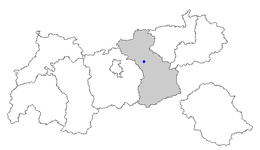Schwaz
| Schwaz | ||
|---|---|---|
| ||
 Schwaz Location within Austria | ||
Location in Tyrol
| ||
| Coordinates: 47°21′00″N 11°42′00″E / 47.35000°N 11.70000°ECoordinates: 47°21′00″N 11°42′00″E / 47.35000°N 11.70000°E | ||
| Country | Austria | |
| State | Tyrol | |
| District | Schwaz | |
| Government | ||
| • Mayor | Hans Lintner (ÖVP) | |
| Area | ||
| • Total | 20.17 km2 (7.79 sq mi) | |
| Elevation | 545 m (1,788 ft) | |
| Population (1 January 2016)[1] | ||
| • Total | 13,444 | |
| • Density | 670/km2 (1,700/sq mi) | |
| Time zone | CET (UTC+1) | |
| • Summer (DST) | CEST (UTC+2) | |
| Postal code | 6130 | |
| Area code | 05242 | |
| Vehicle registration | SZ | |
| Website | www.schwaz.at | |
Schwaz (German: [ˈʃvaːts]) is a city in the Austrian state of Tyrol. It is the administrative center of the Schwaz district. Schwaz is located in the lower Inn valley.
Location
Schwaz lies in the middle of the Lower Inn Valley at the foot of the Kellerjoch and Eiblschrofen mountains. It is located approximately 30 km (19 mi) east of Innsbruck.
The city covers an area of 20.17 km2 (7.79 sq mi).
Neighbouring communities include: Buch bei Jenbach, Fügenberg, Gallzein, Pill, Stans, and Vomp.
History
The Counts of Tyrol guarded Schwaz from nearby Burg Freundsberg. At the town's height during the 15th and 16th centuries, it was an important silver mining center, providing mineral wealth for both the Fugger banking family and, through them, for the Austrian emperors. During this period, its population of about 20,000 inhabitants made it the second largest city in the Austrian Empire, after Vienna.[2]
Schwaz received its city rights in 1898 by Emperor Franz Joseph I of Austria.
Population
| Historical population | ||
|---|---|---|
| Year | Pop. | ±% |
| 1869 | 4,813 | — |
| 1880 | 5,124 | +6.5% |
| 1890 | 5,888 | +14.9% |
| 1900 | 6,545 | +11.2% |
| 1910 | 7,385 | +12.8% |
| 1923 | 7,033 | −4.8% |
| 1934 | 7,738 | +10.0% |
| 1939 | 7,523 | −2.8% |
| 1951 | 8,898 | +18.3% |
| 1961 | 9,455 | +6.3% |
| 1971 | 10,298 | +8.9% |
| 1981 | 10,929 | +6.1% |
| 1991 | 11,839 | +8.3% |
| 2001 | 12,212 | +3.2% |
| 2011 | 11,994 | −1.8% |
Personalities
Schwaz is the birthplace of 16th-century pulpit orator Georg Scherer and 20th-century philosopher Hans Köchler.
Economy
Three large industrial companies have their headquarters in Schwaz:
- Tyrolit – a globally active producer of bonded abrasives
- Adler Lacke – a family-run producer of coating systems
- DAKA – a regional waste management company
International relations
Twin towns – Sister cities
Schwaz is twinned with:
Gallery
 Aerial view
Aerial view_from_NE_a.jpg) Schwaz seen from NE
Schwaz seen from NE Eiblschrofen near Schwaz, seen from N.
Eiblschrofen near Schwaz, seen from N._from_NE_closer.jpg) Schwaz seen from NE, closer
Schwaz seen from NE, closer Schwaz, Parish Church, consecrated in 1502
Schwaz, Parish Church, consecrated in 1502 Tower (der Friedhofsturm) and bust from Ludwig Penz
Tower (der Friedhofsturm) and bust from Ludwig Penz View to a street
View to a street
References
- ↑ Statistik Austria - Bevölkerung zu Jahresbeginn 2002-2016 nach Gemeinden (Gebietsstand 1.1.2016) for Schwaz.
- ↑ Chizzali. Tyrol: Impressions of Tyrol. (Innsbruck: Alpina Printers and Publishers), p. 28
External links
- Web site of the municipality of Schwaz (German)
- Schwaz Silver Mine (German)
- official tourism information of Schwaz (English)
- About Schwaz and surrounding (English)

